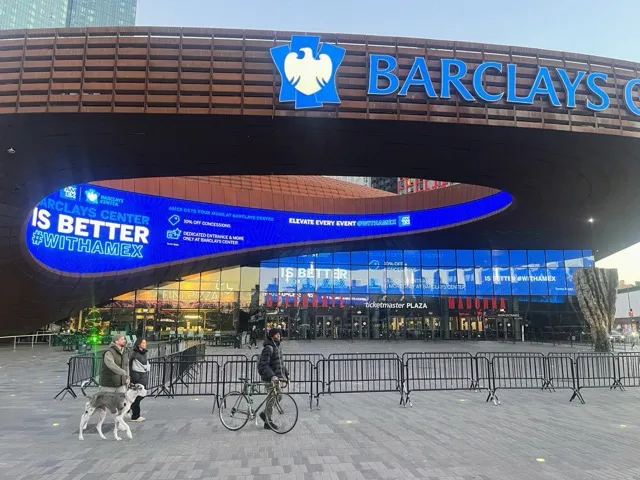The arena company benefits from the temporary plaza, likely more than with the unbuilt Urban Room. NY State seems ready to make it permanent, with no reciprocity.
This is the fourth of five articles about the Sept. 26 meeting of the advisory Atlantic Yards Community Development Corporation (AY CDC). The first concerned BSE Global's plans to use the closed Modell's store for a youth basketball program. The second concerned the expected entry of Related Companies and the obligations for affordable housing. The third concerned plans for a giant, two-tower project at Site 5. The fifth concerned plans for a Quality of Life meeting.
The giant two-tower project at Site 5 would involving transferring bulk from the flagship tower (B1, aka "Miss Brooklyn") once planned to loom over the arena, across Flatbush Avenue to Site 5, longtime home of P.C. Richard and the new-closed Modell's.
The term "preserve," I wrote, suggests that ESD would be conserving something civically valuable rather than also making "permanent"--the actual language in Exhibit K-- a space that's key to arena operations and revenues, and costs the arena operator nothing beyond maintenance.
The urban plaza shall be completed and available for public use upon the date of the opening of the arena. Thereafter, [developer Forest City] shall operate and maintain the urban plaza in good and clean condition, until such time as the area occupied by the urban plaza is required for construction of Building 1 or the Urban Room.
 |
| Ticketmaster Plaza, Dec. 13, 2023. Photo: Norman Oder |
Remember, beyond the building's original oculus, a billboard for advertising, Tsai, who took over in 2019, added an LED wall over the arena doors, doubling the canvas for promotion.
So I think there are several rationales, and avenues, for New York State to claw back some value. In Would Joe Tsai's Slickest Move Be Poaching Ticketmaster Plaza?, I noted that the “temporary” plaza was implicitly predicated on the common ownership—no longer valid—of the arena operator and the project’s master developer, originally Forest City Ratner.
The plaza, barely discussed publicly before the project's approval, was "quietly ceded" to the arena operating company, part of BSE Global, at virtually no cost ($10/year, along with arena!), and was on the verge of being ceded permanently. But the plan to make the plaza permanent, I noted, offered the state leverage.
I've also argued that ESD had other leverage. It could threaten the arena naming rights, given that the bank Barclays, an admitted felon, should be considered a Prohibited Person, barred from state contracts. It also could use the re-approval of that neon art (or is it advertising?) installation over the transit entrance.
 While some at the AY CDC meeting did acknowledge that the plaza clearly had value to the arena operators, they didn't go farther.
While some at the AY CDC meeting did acknowledge that the plaza clearly had value to the arena operators, they didn't go farther.She noted that the AY CDC, in its August meeting, had requested for more information about the plaza.
 |
| Girls basketball camp in July. Photo: Norman Oder |
Drilling down
During the discussion, AY CDC Director Ron Shiffman asked who has the naming rights for the plaza. The arena, he was told.
"The Declaration for the arena site goes into a lot of detail about what would happen when B1 is built, and how that would work in terms of the arena versus that construction," responded ESD attorney Matthew Acocella.
The Arena Parcel Occupant would be able to use the Urban Room for a box office and retail, as well as gain naming rights, signage, and "all economic interests derived from the Urban Zone," while not adversely affecting the rights of the B1 Occupant. The MTA also would have an easement for use by subway passengers.
"So effectively, the economic value to them of relocating B1," he said, "is not to lose access to that space for the intervening years where the B1 building would have been developed."
Who pays?
"No, nothing changes," Acocella said. That would've been the right time to explain that the arena lease expense, in terms of payment to the state, is essentially nil: $10/year, as shown in the screenshot below, from the arena's annual fiscal report.
That, Veconi said, "is good to understand. I mean, it does seem like not moving ahead with B1 does represent some type of a benefit to the lessee in this case, and we should have some kind of recourse to try to--"
"Are you talking about the years that would have been under construction, that they don't lose?" asked Arden Sokolow, ESD Executive VP, Real Estate Development and Planning.
"Among other benefits," observed AY CDC Chair Daniel Kummer.
"And the advantage of having the space, open to the air," chimed in Shiffman.
"As Ron pointed out," Veconi said, "they are able to sell the naming rights as well. Perhaps they could for the Urban Room as well."
ESD's Acocella assented.
Veconi said thanks. "I think that helps to sort of clarify what the situation there is," he said.


Comments
Post a Comment